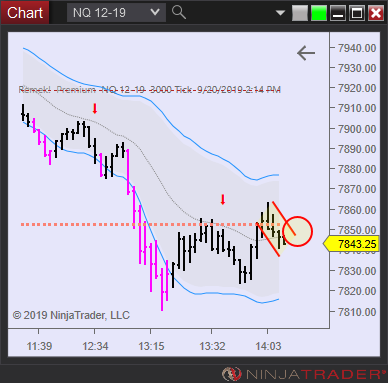While we’re keeping an eye on today’s - rather random intraday - moves on the major US indexes, let’s review how we can enter a pullback trade. We have, basically, three options:
a) enter with the first sign of with-trend momentum. This is the most agressive entry (see jpg on the left). (Note: the Remek! pullback signal is a proprietary algorithm which identifies the emergence of with-trend momentum.)
b) enter on the break of the pullback channel (see jpg in the middle). The safe middle ground between best price and smallest risk. (Note: by the time price breaks out of the channel, the Remek! pullback signal, usually, will have arrived.)
c) often, like on this chart, perhaps the safest way, but the worst price: enter with a stop entry at or above the top of the pullback channel (see jpg on the right).
Less often with c) and more often with a) and b), a subset of all pullback trades, however you enter, will turn into a complex pullback. Have a plan ready to handle those.
Generally, to get a better price you have to assume more risk. In a strong trend supported by a HTF structure, an agressive entry is often justified, while, with a a stop entry, you “join a party” already in progress. (Since c) is, in effect, a breakout trade on our entry chart, we need to be aware that a subset of breakout trades will also fail, which is normal and expected.) Note that with the stop entry, if price turns and we don’t get filled, no harm is done.
Whatever your set of entry rules, make sure you have them well-defined. The time of entry into a trade is no time to improvize. Also, no matter how you enter, it’s basically the same trade, therefore your stops should be placed the same way for all three entry types, and keeping in mind the realities of the market. To put it simply: outside of the expected noise. A conservative target - for any pullback trade - is the most recent high on the trading timeframe. Consider keeping a portion of your position as a ‘runner’, to be trailed until stopped out.
Finally (and this is so obvious we shouldn’t even put it here): whichever entry technique we choose in a given situation, we’ll be working with probabilities. A subset of our trades will always fail, therefore managing our risk at all times is paramount! It’s good practice to build up a large sample size of our trades to see which method works when, in our hands, best.
Ready for Monday?




